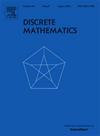The nonrepetitive coloring of grids
IF 0.7
3区 数学
Q2 MATHEMATICS
引用次数: 0
Abstract
For a graph G, a vertex coloring f is called nonrepetitive if for all and all (path of 2k vertices) in G, there must be some such that .
We use to denote the minimum number of colors required for G to be nonrepetitively colored.
In 1906, Thue proved that for all n. In this paper, we focus on grids, which are the Cartesian products of paths. We prove that for sufficiently large n, where the previous best lower bound was 4 and upper bound was 16. Moreover, we also discuss nonrepetitive coloring of the Cartesian product of complete graphs.
网格的非重复着色
对于图G,顶点着色f称为非重复,如果对于所有k∈N且G中所有P2k= < v1,⋯,vk,vk+1,⋯,v2k > (2k个顶点的路径),必须有某个1≤i≤k,使得f(vi)≠f(vk+i)。我们用π(G)表示使G不重复上色所需的最小颜色数。1906年,Thue证明了所有n的π(Pn)≤3。在本文中,我们关注的是网格,它是路径的笛卡尔积。对于足够大的n,我们证明了5≤π(Pn□Pn)≤12,其中先前的最佳下界为4,上界为16。此外,我们还讨论了完全图笛卡尔积的非重复着色问题。
本文章由计算机程序翻译,如有差异,请以英文原文为准。
求助全文
约1分钟内获得全文
求助全文
来源期刊

Discrete Mathematics
数学-数学
CiteScore
1.50
自引率
12.50%
发文量
424
审稿时长
6 months
期刊介绍:
Discrete Mathematics provides a common forum for significant research in many areas of discrete mathematics and combinatorics. Among the fields covered by Discrete Mathematics are graph and hypergraph theory, enumeration, coding theory, block designs, the combinatorics of partially ordered sets, extremal set theory, matroid theory, algebraic combinatorics, discrete geometry, matrices, and discrete probability theory.
Items in the journal include research articles (Contributions or Notes, depending on length) and survey/expository articles (Perspectives). Efforts are made to process the submission of Notes (short articles) quickly. The Perspectives section features expository articles accessible to a broad audience that cast new light or present unifying points of view on well-known or insufficiently-known topics.
 求助内容:
求助内容: 应助结果提醒方式:
应助结果提醒方式:


